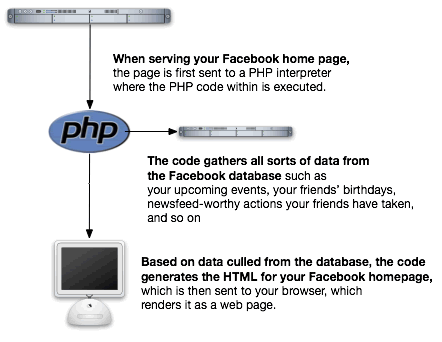Over at the Tucows Developer Blog, I have another installment in my series of articles on developing Facebook Apps in PHP: Using the FacebookRestClient Class’ “Group” Methods, Part 1.
My friend Miss Fipi Lele sent me a scan from The Usborne Guide to Computer and Video Games, a children’s book published in 1982:

Image courtesy of Miss Fipi Lele.
I was quite impressed with how many predictions the book got right. Here are some excerpts from the “Videogames in the future” section of the book, followed by examples of the predictions coming true.
Here’s what the Guide had to say about “TV games” in which you can take part in battles. Remember, this was published when the Atari 2600 (which was still called the Atari VCS — short for “Video Computer System”) and the Mattel Intellivision were established consoles and the Colecovision had just been released:
A TV game with a very large memory will be able to reconstruct detailed pictures of say, the Battle of Waterloo or a space battle, and the players will be able to control far more of the details in the picture than they can today.
Score one point for the Guide. Although the game History Channel: Civil War got poor ratings, it fulfills the prediction. Here’s a screenshot:
Here’s the Guide on sports games:
In TV sports games you will probably be able to control each of your team members individually. These games will also have electronically synthesized voices and the referee will tell you when you are offside or given a free kick.
Score another point for the Guide. Here’s FIFA Soccer 2008:
The Guide has this to say about multiplayer games:
At present, most computer games are for only one or two players. More powerful computers though, will be able to cope with instructions from a number of people playing at the same time, either as teams against each other, or against the computer.
Another point for the guide! Case in point: a video of gameplay from the Halo 3 multiplayer beta…
Video duration: 9 minutes, 48 seconds.
And finally, here’s what the Guide predicts for handheld games:
Hand-held electronic games will still have liquid-crystal displays, but they will probably be in full colour and will be as detailed and realistic as pictures for a TV programme today.
Yet another point for the Guide: here’s Burnout Dominator for the PSP…
Late-Breaking Update
Serves me right for not Googling first: the Level Up blog at Sun has a complete set of scans of the book. Check it out!
 By now, you’ve probably heard that for a brief period, a server configuration error caused some Facebook users to see its PHP code rather than the familiar Facebook pages that the code was supposed to render.
By now, you’ve probably heard that for a brief period, a server configuration error caused some Facebook users to see its PHP code rather than the familiar Facebook pages that the code was supposed to render.
How the Code Got Out There
Tony Hung at Deep Jive Interests asked the question “Could a server misconfiguration send out the whole source code in its entirety when you put in the Facebook URL?”
It seems strange that such a simple thing could give away your source, but as anyone who’s set up PHP on a server a number of times will tell you, it can happen.
When you visit a static HTML page — that’s a plain old HTML page that wasn’t generated by some server-side script written in PHP or any number of programming languages — the web server simply hands over the contents of the page (the HTML) over to your browser. Your browser renders the HTML as a web page:

The opposite of a static page is a dynamic one, in which the content is generated on the fly — the server isn’t just handing over the contents of a file. Instead, it calls on some program to cull data from one or more sources and then use that data to assemble some HTML which is then sent to your computer:

What happens when the server is configured incorrectly in such a way that the code for a dynamic page never gets sent through the code interpreter? One common result is that the code gets sent directly to the user. Instead of seeing the result of running the code, the user ends up seeing the code itself. That’s what seems to have happened with Facebook.
I had my first real-life encounter with the OLPC XO at the CommandN 100th episode party last Thursday. Mike Fletcher, whom I consider to be Toronto’s Python go-to guy, is contributing to the OLPC effort and brought the his to the party.
Its look is reminiscent of my beloved first Apple laptop, the original “clamshell” iBook, or perhaps of Fisher-Price toys designed in the age of Star Trek: The Next Generation. Its appearance seems to announce that it’s both durable and fun:

The OLPC, side-by-side with my accordion. The OLPC is considerably more compact and easier to carry, which explains why the “One Accordion Per Child” idea never caught on.
It’s designed for kids from the get-go. The integral handle is best suited to a child’s hands, and beside the handle are a couple of holes so that kids can loop a shoulder strap, belt, sash or rope for over-the-shoulder carrying. The keyboard is the sealed, rubberized type, which should make it spill- and dust-resistant.

The network screen on the XO. There wasn’t another one in the room, so there’s not much on this screen.
The keys are clearly designed for kids’ hands. I wonder if Mike plugs in a USB keyboard to code on it:

Adult hands contrasted with the XO’s keyboard.
I saw some of the applications in its built-in suite, including the browser, word processor, drawing app and a music making app. I’m told that there’s a programming environment for kids to make their own application, although I didn’t get a look at that.

The screen can also be rotated 180 degrees and then pressed shut so that the OLPC becomes a handy ebook reader. It’s a helluva lot nicer (and cheaper) than many other ebook readers I’ve seen:

The XO in its “ebook” configuration.
Over at Ed Felten’s Freedom to Tinker blog, there’s a review of the XO written by a very articulate 12-year old named “SG”. Although SG isn’t quite in the OLPC’s target demographic, s/he’s in the right age group.
Other OLPC Links
Notes from FacebookCamp, Part 1
FacebookCamp

The calm before the storm: the MaRS centre auditorum before people arrived.
Last night’s FacebookCamp was a success, packing the main auditorium of Toronto’s MaRS Centre (which was ready to seat 420 people) as well as spilling over into an extra room with simulcast video. It’s estimated that about 450 people attended, which makes this event the largest “Camp” style developer event ever held in Toronto.

15 minutes before the opening presentation.
Rather than comment on the event right now, let me jump into the notes! I’ll talk about the event in a later post.
Introduction (Andrew Cherwenka of Trapeze.com and Roy Pereira of Refresh Partners)

- Thanks to Facebook for flying up here to a “cooooold” Canadian summer
- Thanks to MaRS for letting us use their space
- The number of people attending grew so much that we had to keep changing venues to accomodate them — MaRS is our fourth venue!
Some facts about Facebook:
- 54+ million users
- 15 billion pageviews/month
- Toronto is the 2nd largest Facebook community in the world, with 724,000 members
- We were recently surpassed by London, but on a per-capita basis, we still beat them
- 5 of the top 10 Facebook regions are Canadian — Winnipeg and Hamilton each have more users than San Francisco!
- 2400+ approved applications representing 100 million downloads
FacebookCamp:
- We hope that this the first of many
- We want to encourage Toronto-based developers and organizations to build for and use Facebook, and leverage it to make money!
- Tonight’s presentations will be more developer-centric and technical in nature
- The next FacebookCamp will be more geared towards marketing and business development — it’ll be sometime in the fall
We’d like to thank our sponsors and those who helped out:
- MaRS
- Trapeze
- Refresh Partners
- David Crow and TorCamp
- This is the first Facebook Developer Garage outside the US
Let’s have a show of hands!
- How many developers in the audience? [About 40% raise their hands]
- How many marketers in the audience? [About 40% raise their hands]
- How many people from outside the GTA (Greater Toronto Area)? [A few hands go up]
- If you’re blogging this event or posting pictures on Flickr, please tag it with FacebookCampToronto so other people can easily find it
- Participate! Add to the Facebook Developer Wiki, and join the TorCamp Google Group.
Best Practices Around Product Design and Viral Marketing (Meagan Marks, Facebook)
Intro by Caitlin O’Farrell, Facebook

- Toronto is home to one of the biggest Facebook developer communities
- We want you to build apps that integrate deeply with Facebook
- We ask that you do not videotape Meagan’s presentation
- I’m excited, a little nervous
Meagan’s Presentation

Who am I?
- My title is Platform Manager
- You can find me on Facebook
- I’m an “appaholic”
Why are we here?
- Developer Garages popping up all over the US
- Facebook is the #1 site in Canada
- Canada: home to 10% of all active Facebook developers
- Toronto is in top 10 largest Facebook developer communities, beating out San Francisco and San Jose for apps with more than 5 users
- 3.3 million active users in Canada (by “active”, we mean users who log in more than once a month)
- 61% of the active users are out of college
- 68% of the active users log in daily
- Facebook gets 8.5 billion pageviews a month from Canada
- In total, there are 33 million active users
- We get 150,000 new users every day
- There are 90,000 Facebook developers
- There are 1700 apps with more than 100 users
- It’s been only a couple of months since the Facebook platform was launched (at f8, in the Bay Area)
- A number of popular apps have spring up since then: Zombies, Pirates, Scrabulous, Crackbook (credit to Amber Mac for that name) and Appsaholic
Facebook Platform:
- What is Facebook Platform?
- Google Maps, OS X dashboard widgets — noth are examples of platforms
- Facebook’s platform is built on the Facebook Social Graph, which is made up of the connections between Facebook users
Facebook cares about:
- Identity
- Information
- Social Context
Ninja Tricks
- Popular apps make use of deep integration with Facebook
- We’ve studied the apps that did best, and here’s a breakdown of how users found them:
- About 1/4 discovered an app through the News Feed
- About 1/6 discovered an app through the Profile
- About 1/6 discovered an app through the Product Directory
- About 1/3 discovered an app through some other means

Profile integration

- A lot of Facebook’s built-in features are actually apps that are built on the platform
- The Mini Feed is a good way to promote your app — write to it!
Profile Box

- Users want to see recent interactions and be notified of them — who did what?
- If users don’t see updates from your app, they’ll remove it
- Timestamps are important too — users want to know when things happened and about recently added content — notify them!
- Make your notices socially relevant: mention the user’s friends! Users want to know “Who of my friends did something?”
- People use Facebook content for self-expression and as a means social promotion — think about what people want to share
- The Profile is how people share info about themselves
- People post pictures, video and notes — content that is “precious to them”
Canvas Pages

- The Canvas Page is where users are taken when they click on an app
- The idea is for your app to use the Canvas Page to keep a captive audience
- Use “Call to Action” buttons — big buttons that encourage people to initiate some kind of action
- Track the important actions in the feed, e.g. “Alice wrote on Bob’s wall
- Rather than bombard the Feed with lots of tiny actions, aggregate actions together into a single notification for the Feed
- Use social comparisons based on actions, e.g. In a quiz, compare the user’s score with his/her friends’ scores: “Alice is smarter than 20 of her friends”
More Integration Points

There are other less-used integration points in Facebook that you may wish to consider using:
- Message
- Message attachments — e.g., when a user installs a song app like iLike, you can offer to send a friend a song as a message attachment
- Profile actions
- Wall
- Share buttons — call on the user to share the app — no biz deals with Facebook are needed to make use of these
Mass Distribution and Getting Users:
- >75% of active users have at least one Facebook app installed
- The largest app has 10 million users
- The best way to grow your app is to feed the Mini Feed
- Track interactions and push them to the user via feeds, but not so much that you spam the user
- Use the Mini Feed to “show off” — show the user’s friends that they’re missing out by not using your app
- Apps are free, so it’s a low-risk
- The temporal element is important: Note the time someone did something

News Feed Optimization:

- Increase the relevancy of your News Feed items — make sure that those items are things users care about — if 10 of my friends and I are doing the same thing, I want to know about it!
Build apps to promote your core business:

- Example: Boozemail. Seems trivial, but its creators are using it to promote their toolbar to Facilitate meetings
- Cross-promote: Make deals with other developers to promote their apps within your app — Flickster and Top Friends are cross-promoting each other

New Opportunities: Virtual Currencies

- Think of virtual currencies, such as the one in (fluff)friends
- It makes use of a currency called “Munny”
- Users of this app have virtual pets that live on their Profile page
- If you pet my virtual pet or take care of it, you get munny, which can be converted to “food” (virtual food for virtual pets), virtual gifts to send to other (fluff)friends users, and so on
- These are “incentive-based actions” that lead to “interaction capital”
- You also get recognition for your actions: “Meagan has petted pet xxx”
- Use this recognition to let your users build “street cred” or karma
- Red Bull’s Rock-Paper-Scissors game is another good example
New Opportunities: Ad Networks

- You can run ads on your app’s Canvas Page, but not in the Profile
- Impressive CPM: $15/20 CPM for top apps
- Some app developers are showing really good numbers from advertising:
- Some are quitting their day jobs
- VCs in the Bay area looking for Facebook app developers
- Some applications are self-sufficient without an existing base anywhere else on the Web — they’re solely on the Facebook platform
New Opportunities: APIs on APIs (“So meta!”):

- e.g. the Super Wall API, which is an API for their application, which in turn is built on the Facebook API
- Super Wall was created in 3 days and drew in 2 million users in 2 weeks
Metrics to consider: The Facebook Effect

- If you have an external site, you won’t be cannibalizing it by drawing people to your Facebook app
- If anything, Facebook brings traffic to your site
- HotOrNot and RockYou can trace growth back to traffic driven to them from their Facebook apps
- It’s a virtuous cycle, supporting growth both directions
Metrics to consider: Vitality Metrics
- Installed base
- Growth of new users
- Outgoing impressions — note that impressions are not notifications
- Conversion rate
- Your app will get lower numbers if it’s not content-oriented or if it doesn’t have some kind of meaning to your users
Metrics to consider: Engagement Metrics

- Canvas page visits
- Canvas page duration
- Installed users * Impressions/Installed user * Acquisitions/Impressions = New users acquired
- It’s all about connections and network effects
- If you’re keeping your users engaged, that sends out more impressions and attracts more users
- Focus on interactions on the Canvas page rather than outgoing impressions
- Think about engaging your existing users rather than obsessing over growing your user base — “New users is not the be-all and end-all”
In Closing
- Build!
- Get started at developers.facebook.com
- Install the developer app
- Watch the feed on the developer app! It’ll keep you up to date on changes to Facebook that might affect your app
- We’ve removed the “Courses” feature, which dates back to when we were just for colleges: we think the development community can do it better, so we decided to open up that opportunity to the dev community
- Contribute to the wiki — wiki.developers.facebook.com
- You guys are a huge asset
- We’ve seen apps get traction that wouldn’t have gotten it without Facebook
Q & A
Question: What’s the uninstall rate for Facebook apps?
Answer:
- I have the data on my laptop, but haven’t memorized it; see me afterwards
- Uninstall numbers are low and declining
- Certain apps have rapid uninstalls — most of time because they’re spammy
- Apps that are “spammy” — those that send messages that are misleading, damage trust or abuse the relationship with the user — will get their notifications throttled back or disabled by us
Question: What are the top 3 and bottom 3 apps?
Answer:
- Don’t have the numbers memorized
- I believe Top Friends is the number 1 app, with about 10 million users
- You can see for yourself — look at the “Browse Apps” leaderboards for app stats
Question: Do sites that integrate with Facebook have to pay?
Answer: No, it’s free! You have to have your own servers and engineers, though.
Question: Is the “Action” menu being removed?
Answer: If the user doesn’t have an app installed, s/he shouldn’t see it in the profile.
Question: Can you give us any insights into the Facebook roadmap?
Answer: I can only talk about “the state of the world as it is today”.
Question: What’s your stance on “policing” Facebook?
Answer:
- We prefer a “hands-off approach”
- You can’t distribute copyrighted material, as per the terms of service
- Read the terms of service and don’t violate them
- Please settle disputes between you and other app develoeprs (say, “copycat” apps) yourselves
In the Next Installment…
Next time, I’ll post my notes and photos from the other presentations.

What Does Tucows Do?
Since I work at Tucows, I get asked this question a lot: What does Tucows do?
Here’s the short answer, which should do for the purposes of this article: Tucows is in the business of providing wholesale services to ISPs and hosting services, such as domain name registration and email. The ISPs and hosting services then provide these services to their customers. By buying our wholesale services rather than implementing and maintaining these services themselves, they can concentrate on customer service.
Tucows’ Domain Prices: Lower and More Transparent
The announcement on the Tucows Blog puts it so well that I’ll just quote it:
How’s this for a radical idea: Charge less for each domain, then add more services and features and then fully explain where every penny of each transaction goes. It sounds crazy, but that’s exactly what we’re doing starting today.
For example, our price of a .com domain used to be US$10.05, and now it’s dropped to US$9.20. Here’s how it breaks down:
| Item | Cost |
|---|---|
| .com registration (charged by the registry) | US$6.00 |
| ICANN fee | US$0.20 |
| Tucows management fee | US$3.00 |
In pie chart form, the cost breakdown looks like this:

Here’s what the Tucows management fee covers:
- Free Name Suggestion Tool powered by DomainsBot
- 50% of net domain parking revenue
- The ability to sell any of hundreds of thousands of premium domain names
- Access to a library of APIs and web-based tools for provisioning and management of domains
- Technical support
And come September, these will also become available with every domain name:
- Free WHOIS Privacy
- Free Managed DNS
For more details, see our news release and our blog article.
Facebook Developer Garage Tonight!

Tonight’s the night: Facebook Developer Garage (a.k.a. FacebookCamp) happens tonight at 6:30 p.m. at the Mars Discovery District (101 College Street, Toronto). This will be the first of a series of Facebook Garages/Camps; there’s already talk of holding another one for the fall. If you’re interested in developing applications to run on the Facebook platform, this is a must-catch event, as not only are about 300 local developers planning to attend — the event has garnered so much attention that Facebook is flying reps up to speak. As you can imagine, seating will be limited, so if you can come early, do so.
I’ll be taking my usual copious notes and will post them here, so watch this space!
Here’s the schedule of tonight’s events:
| When | What’s Happening |
|---|---|
| 6:00 p.m. | Social/mingling |
| 6:30 | Introduction by Colin Smillie Roy Pereira and Andrew Cherwenka |
| 6:40 | Best Practices around Product Design and Viral Marketing by Meagan Marks, Facebook.com |
| 7:30 | Anatomy of a Facebook Application by Jay Goldman and Michael Glenn, Radiant Core |
| 7:50 | FBML Overview by Sunil Boodram, Trapeze Media |
| 8:10 | FQL Overview by Craig Saila |
| 8:30 | Updating the Facebook Profile by Colin Smillie, Refresh Partners |
| 8:50 | Demo: .Net Sample Application by Ricardo Covo |
| 9:00 | Demo: Carpool by Zimride by Rajat Suri |
| 9:10 | Demo: Ogrant by Shachin Ghelani |
| 9:20 | Wrap-up and drinks |






